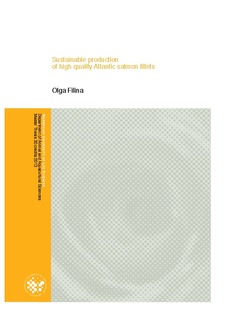Sustainable production of high quality Atlantic salmon fillets
Abstract
The aim of study was to identify the effect of Atlantic salmon (Salmo salar) energy status in
the late summer on fat accumulation in the autumn, and to investigate whether it is
possible to improve utilization of limited dietary marine oils by feeding salmon high
content of omega-3 rich oils during the season where salmon are accumulating fat before
the winter.
The present study was conducted with Atlantic salmon (1+ smolt) transferred to sea in July
2010. In May 2011, 1950 fish with an initial mean body weight of 1 kg were pit-tagged and
distributed into three net pens. During the period from May to August three different prediets were used: FPD, 34% fat; MPD, 18% fat, 100% ration and LPD, 18% fat, 50% ration of
the MPD. In August 2011 the fish were redistributed into eight net pens, four net pens for
each of two main diets: VO, a standard diet with a lipid fraction composed by 70% rapeseed
oil and 30% South American marine fish oil, and MO—a standard diet with a lipid fraction
composed by 70% South American marine fish oil and 30% rapeseed oil. From November
to the termination of the experiment in December 2011, the group that had been given the
MO diet was switched to the VO diet. The sampling points were August (before the start of
fat accumulation), October (the period of intensive fat accumulation) and December (no fat
accumulation). Length, whole body, gutted body, fillet and organ weights were recorded.
Proximate and fatty acid analyses were performed on fillet segments, viscera, liver and
heart.
The aim of pre-dietary treatment was to produce salmon with different fat content and
growth potential. The FPD group with initially high body weight and muscle fat content had
lowest growth and the fat accumulation rate during the experimental period compared to
the MPD and LPD groups. Viscera mass index significantly decreased in the FPD fish and
increased in LPD fish. The development of lipid content in viscera, liver and heart showed
the same tendency as development of lipid content in skeletal muscles. During the
experimental period the fat accumulation rate in viscera and liver was the lowest in the
FPD group and highest in the LPD group. Liver mass index increased significantly during
the experimental period in the LPD fish that indicates high intensity of metabolic processes
in this group. Heart mass index and the rate of fat accumulation in heart were the highest in
the LPD group as well.
